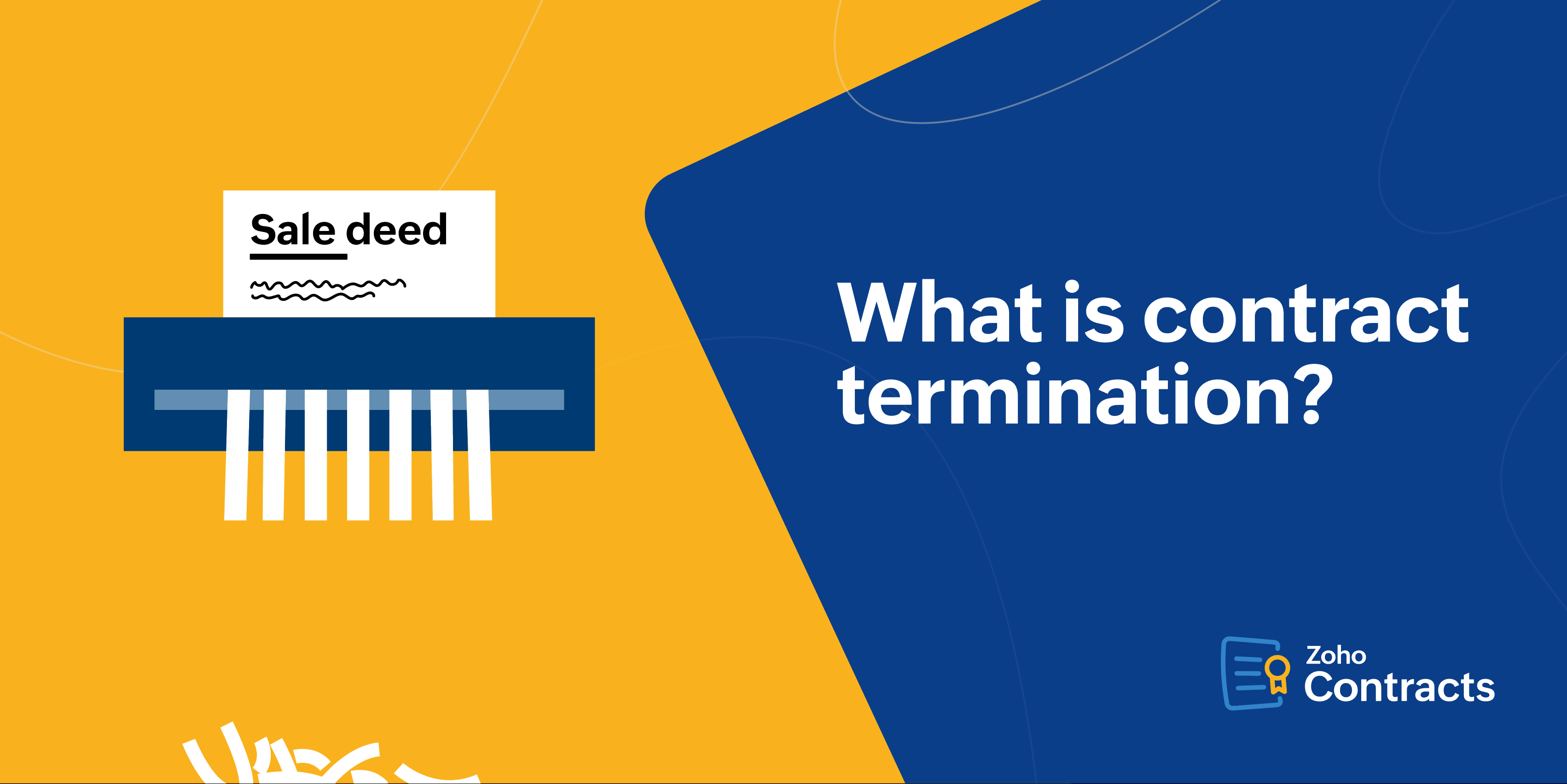- HOME
- Contract Management
- What is contract termination?
What is contract termination?
- Last Updated : July 10, 2024
- 1.2K Views
- 6 Min Read

Contract termination refers to the ending of an active contract by one or all involved parties before the contractual obligations have been fulfilled. Termination of a contract most commonly takes place because one party fails to fulfill its obligations, both parties agree to end the contract mutually, or when external circumstances make it difficult to fulfill contractual terms. Contract termination can have legal complications for a business, especially if the contract is terminated wrongly or in breach of contract terms.
In this blog post, we’ll explore the common reasons for termination of a contract, how to terminate a contract, the impact of contract termination, and how a CLM can help with the contract termination process.
Types of contract termination
All contract terminations can be broadly classified into two categories:
Termination for convenience
This clause is a provision in a contract that allows one or all parties to terminate a contract without a cause or breach of contract. It gives parties flexibility to end their contractual relationship even if the other party or parties are performing satisfactorily.
This form of contract termination is employed to conclude relationships in a more amicable manner and exit contracts that are no longer mutually beneficial.
Termination for cause
This clause is a provision that allows one party to terminate a contract when the other party or parties fail to fulfill their obligations or breach the contract terms. It outlines the specific circumstances under which a contract can be terminated by any party. It may also specify the notice period and remedies available to the non-breaching party. Most contracts have a termination for cause clause.
What are the reasons for contract termination?
Some of the common reasons for termination of a contract include:
Breach of contract: A party fails to fulfill its obligations as mentioned in the contract, such as the delivery of goods and services on time or not paying on time for services.
Mutual agreement: All parties mutually agree to terminate the contract for any reason they feel appropriate.
Bankruptcy or insolvency: One of the parties becomes bankrupt or insolvent, and becomes financially incapable of fulfilling its obligations.
Completion of purpose: When the contract has achieved what it was signed for, rendering further performance unnecessary.
Force majeure: Unforeseeable circumstances—such as natural disasters or war—that are out of the parties' control make it impossible or difficult to fulfill contractual obligations.
Violation of law: The performance of a contract becomes impossible or illegal due to changes in regulation and legislation.
Fraud or misrepresentation: One of the parties enters a contract based on false information provided by the other party.
Repudiation: One party explicitly states that it does not intend to fulfill its contractual obligations.
Best practices for termination of a contract
Termination of a contract is a big decision, and one that needs to be taken carefully. Ensure to review the contract terms carefully and understand the termination clause, notice requirements, and consequences of termination. Here are some best practices to follow in the event of contract termination:
Document the breaches: If the termination of the contract is due to a breach, document the breaches clearly with evidence to support your claim.
Communicate clearly: Provide the reason for termination to the parties and follow any notice requirements, including providing a written notice if necessary.
Negotiate: If breach of contract is not the reason for termination, try to negotiate with the other party to arrive at a mutually acceptable resolution. This could mean amending the contract or providing compensation if required.
Ensure legal compliance: Ensure the termination complies with all of the relevant laws and regulations in your jurisdiction. If necessary, seek legal assistance.
Protect confidential information: Contracts contain confidential information. During termination, ensure any sensitive or confidential information that was exchanged remains protected even after the contract has been terminated.
Be professional: Keep all communications strictly professional. Do not engage in any sort of personal attacks or threats during the process.
Address ongoing obligations: Clarify how any existing obligations, such as the delivery of goods or services or payments, will be addressed after termination.
Prepare for a smooth transition: If applicable, work with the other party to ensure a smooth transition out of the contract, including transferring responsibilities or assets as necessary.
Repercussions of contract termination
When a contract is terminated before its expiry, it can have repercussions on a business. Broadly categorized, these effects can be under:
Legal: If the contract termination feels unjustified to the other party, or if contractual terms were not followed properly during the termination, legal action can be taken against the party that initiated the termination.
Financial loss: A premature termination can result in financial penalties or loss of payments and deposits already made. In addition, contract terminations also usually involve other costs such as lawyer fees, court expenses, and other settlements.
Loss of goodwill: Termination of a contract without any evidence to back your claim of a breach of contract, or one that is disputed by the other party, can make a dent in your reputation with the other party as well as in the industry. It can strain your business relationships and make it difficult to collaborate in future contracts.
The need for a contract termination letter
Termination clauses often mandate a written letter from the party that wishes to terminate the contract. The letter should state the intent of the party for contract termination.
The termination letter is a formal notification to the other party and also serves as written documentation of the termination. It includes the effective date of termination and the reasons for the same, which can be helpful for legal purposes and to avoid disputes at a later stage.
The contract termination letter establishes a clear understanding between the parties regarding the end of the contract and elucidates the timeline for fulfillment of any remaining obligations.
Sending a termination letter in a professional and respectful manner helps maintain a positive relationship with the other party, even in the event of contract termination.
Ways to prevent contract termination
While the decision to terminate a contract is usually an intentional one, rarely, there are factors beyond the parties’ control that may lead to contract termination. However, a contract termination can be prevented if the parties adopt the below practices:
Maintain clear and open communication with the other party.
Address any concerns promptly.
Conduct regular reviews of the contract’s terms and obligations.
Be flexible and as accommodating as possible.
Seek legal advice if you are unsure of any part of the contract.
Consider renegotiating the contractual terms and amending the contract rather than terminating it.
How a CLM software helps in the contract termination process
A CLM software can prevent contract termination due to renewal misses because it offers automated alerts and notifications that can remind you of an impending contract expiry or renewal.
The extensive obligations module offered by CLM systems help you keep track of obligations, nudging your counterparty in case the fulfillment of obligations is being delayed. This opens room for communication and prevents contract termination.
Most software offer detailed audit trails that track all of the activity in a contract, organization, as well as at a user level. These insights can help in the documentation process in the event of a contract termination.
Software such as Zoho Contracts offers a smart letter template for termination. This letter is auto-generated in the event of a termination, capturing all details, including insights into the financial loss or gain you will face as a result of the termination. You can then send the letter to the counterparty for digital signature or wet signature.
 Akshaya Ganesh
Akshaya GaneshA journalist turned marketer who loves to travel.


